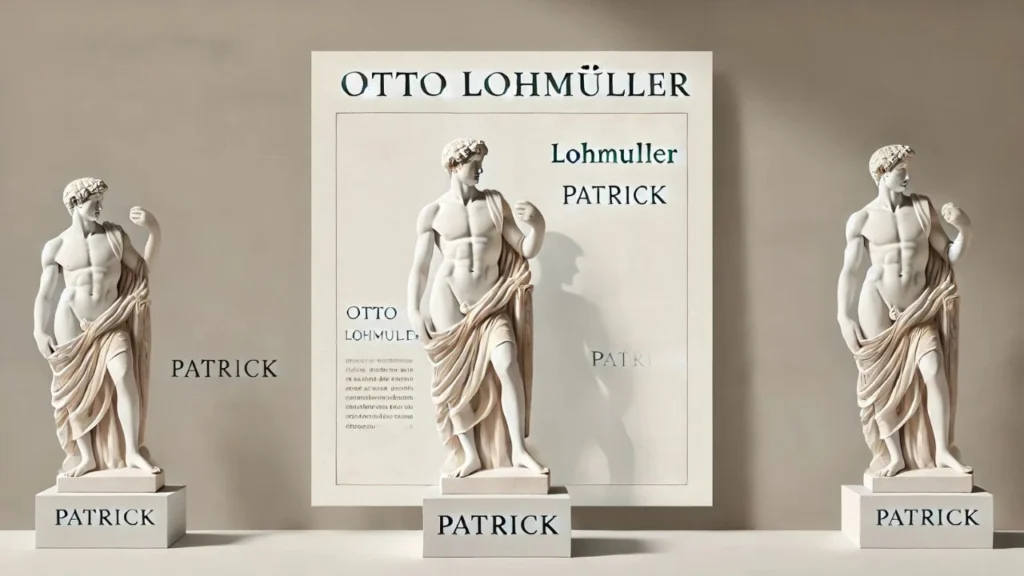Otto lohmüller patrick is a German figurative artist known for his unique depictions of the human form, particularly adolescent males, often depicted in classical, relaxed poses. One of the most notable figures in his work is Patrick, who has become central to understanding Lohmüller’s artistic vision. Through his art, Lohmüller explores themes of innocence, youth and emotional depth, with both praise and controversy.
In this article, we’ll take an in-depth look at the symbolism behind Patrick, the evolution of Lohmüller’s art, and the real-life experiences of those who have interacted with his work.
Otto lohmüller patrick: A Background
Otto Lohmüller was born in 1943 in Gengenbach, Germany. From an early age, he was fascinated by classical art, especially the works of Michelangelo and Caravaggio. His artistic career began in Paris, where he trained as a printer and continued to study independently. Over the years, Lohmüller developed a distinctive style, characterized by near photographic realism that often depicts the human figure, particularly young men, in pensive, serene poses. He began exhibiting his work publicly in the 1970s and has since gained international recognition.
Lohmüller’s art is primarily representational, focusing on the detailed anatomy of the human body with minimal background. His work reflects a deep respect for classical traditions, yet it introduces modern elements that make his pieces accessible and relevant even today.
Key Themes in Lohmüller’s Work
- Youth and Innocence: A central theme in Otto lohmüller patrick art is the portrayal of youth, symbolized particularly by Patrick, a figure that recurs throughout his body of work. Patrick is often depicted in natural settings or in plain, unadorned backgrounds, emphasizing his purity and innocence. Lohmuller’s portrayal of Patrick evokes a sense of vulnerability and emotional depth
. - Classical Realism with Modern Sensibilities: While Lohmüller’s work is rooted in classical art traditions, his use of soft tones, fluid lines and minimal settings give his paintings a modern touch. This approach allows his audience to appreciate the timeless beauty of the human form while connecting with emotional and philosophical undertones.
Wikipedia
. - Symbolism of Patrick: In many ways, Patrick is more than just a character. It is a philosophical musing on Otto lohmüller patrick youthful fragility and the fleeting nature of innocence. Patrick’s pensive pose invites the viewer to reflect on his own experiences growing up, the transition from childhood to adulthood, and the loss of innocence that often accompanies it.
.
User Experience: An Insightful Journey with Lohmüller’s Art
Let’s take a look at the experience of Maria, a collector, who first encountered Lohmüller’s work at an art exhibition in Munich. Maria was drawn to Patrick’s minimal yet deeply emotional portrayal in one of the paintings. At first, she wasn’t sure what to make of the look, but as she spent more time with the piece, she began to understand the emotional depth that Lohmuller had incorporated into his work. .
Maria’s Experience
“At first, I thought Otto lohmüller patrick portrayal of young boys was too simple, but the more I studied the painting, the more I could see the layers of meaning. Patrick’s figure really stood out to me, Especially his eyes—there was something almost sad about them. He seemed to be caught between two worlds, childhood and adulthood. I felt that I could see my own experiences reflected in it. After learning more about Lohmüller’s philosophy, I came to appreciate his work even more. It’s not just about the technical skill, which is extraordinary, but also the emotions he evokes through these simple yet profound scenes.”
Maria eventually bought one of Lohmüller’s small pieces featuring Patrick and found that the painting resonated with her on a personal level. She hangs it in her home and says it often sparks conversations with visitors who are curious about the art’s deeper meaning.
Understanding the Controversy
Although many admire Otto lohmüller patrickartistic skill and emotional depth, his work has not been without controversy. Its focus on teenage males, particularly the recurring image of Patrick, has led some critics to question its motives. However, Lohmüller has consistently defended his work, saying that it aims to capture the beauty and innocence of youth, not exploit it.
In interviews, Lohmüller has emphasized that his art aims to celebrate the purity of childhood and the human form. He emphasizes that Patrick is a symbol of universality, representing youth across cultures and time periods rather than being tied to a single individual.
Table: Key Themes in Otto Lohmüller’s Work
| Theme | Description |
| Youth and Innocence | Patrick symbolizes the purity and vulnerability of childhood |
| Classical Realism | Blend of classical techniques with modern sensibilities |
| Emotional Depth | Lohmüller’s subjects evoke contemplative and introspective emotions |
| Controversy | Focus on adolescent males has sparked debates about artistic intent |
| Legacy | Influential in the realism movement and celebrated for technical mastery |
Legacy of Lohmüller’s Work
Otto lohmüller patrick contributions to the art world are substantial. His ability to combine technical precision with emotional resonance has inspired many artists, particularly those working in the surrealist movement. His artworks have been exhibited in galleries and museums across Europe, and his sculptures have been commissioned for public spaces. Lohmüller’s art challenges viewers to consider themes of vulnerability, innocence, and the passage of time—concepts that resonate deeply with many people.
In addition to his work in painting and sculpture, Lohmüller also illustrated songbooks and literary works, further demonstrating his versatility as an artist. His publishing company, Zeus Press, produced several volumes of his art, making his work accessible to a wider audience.
Conclusion
Otto lohmüller patrick, especially Patrick’s portrayal, offers a unique glimpse into the delicate balance between realism and idealism, innocence and experience. Her work, though sometimes controversial, invites viewers to consider universal themes of youth, vulnerability, and emotional depth. For people like Maria, Lohmüller’s art is more than just a visual experience—it’s an emotional journey that resonates on a deeply personal level.
Lohmüller’s legacy shapes the world of contemporary art, influencing future generations of artists and challenging viewers to explore the deeper meaning of the human form. Whether admired for his technical skill or for his emotional depth, Otto Lohmüller’s work undoubtedly leaves a lasting impression.
FAQs about Otto Lohmüller’s Work
Q1: What is the significance of Patrick in Lohmüller’s art?
Patrick represents an idealized vision of youth and innocence in Lohmüller’s work. He is often depicted in contemplative poses, symbolizing the fragility of childhood and the inevitable transition into adulthood.
Q2: Why has Lohmüller’s work been controversial?
Lohmüller’s focus on adolescent males, particularly in the form of Patrick, has drawn criticism from some quarters. However, the artist defends his work as a celebration of innocence and beauty, devoid of any exploitative intent.
Q3: Where can I view Lohmüller’s work?
Lohmüller’s art has been exhibited in galleries across Europe, and his published volumes are available through Zeus Press. Additionally, his sculptures can be found in public spaces in Germany and other parts of Europe.
Q4: What themes does Lohmüller explore in his work?
Lohmüller’s art primarily focuses on youth, innocence, and the emotional depth of the human form. His works often depict young boys in serene, contemplative poses, inviting viewers to reflect on their own experiences of childhood.
Q5: What has been the impact of Lohmüller’s work on contemporary realism?
Lohmüller’s detailed, near-photographic style and his ability to convey emotional depth have influenced many artists in the realism movement. His work continues to be celebrated for its technical skill and philosophical undertones.







